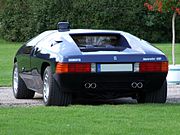Isdera Imperator 108i
This article needs additional citations for verification. (June 2018) |
| Isdera Imperator 108i | |
|---|---|
 | |
| Overview | |
| Manufacturer | Isdera GmBH |
| Production | 1984–1993 30 units produced |
| Assembly | Leonberg, Germany |
| Designer | Eberhard Schulz |
| Body and chassis | |
| Class | Sports car (S) |
| Body style | 2-door coupé |
| Layout | Rear mid-engine, rear wheel drive |
| Platform | Fibreglass body over tubular steel chassis |
| Related | Mercedes-Benz CW311[1] |
| Powertrain | |
| Engine |
|
| Transmission | 5-speed ZF manual |
| Dimensions | |
| Wheelbase | 2,480 mm (98 in)[2] |
| Length | 4,220 mm (166 in)[2] |
| Width | 1,835 mm (72 in)[2] |
| Height | 1,135 mm (45 in)[2] |
| Curb weight | 1,250 kg (2,756 lb)[2] |
| Chronology | |
| Predecessor | Isdera Spyder 033 |
| Successor | Isdera Commendatore 112i |
The Isdera Imperator 108i is a low-volume German sports car produced from 1984 to 1993. The Imperator 108i was born out of the Mercedes-Benz CW311 concept car from 1978, which Eberhard Schulz, who at the time worked as a design engineer for Porsche, designed in his free time. Mercedes-Benz had no interest in putting the CW311 into production, so Schulz established his own engineering company, Isdera, to produce the car under his own brand.[3]
Specifications and performance
[edit]Implementing a fiberglass body upon a tubular steel spaceframe, the Isdera Imperator 108i was comparable to the exotic sports cars of its day. Little was changed from the original Mercedes-Benz show car with the most noticeable changes being the replacement of the pop-up headlights with two fixed units and more conventional tail lights sourced from Mercedes-Benz. The original Imperator 108i featured a 5.0 L (5,000 cc) Mercedes-Benz M117 V8 engine which gave the vehicle a top speed of 283 km/h (176 mph) and a 0–97 km/h (0–60 mph) acceleration time of 5.0 seconds. As Mercedes-Benz developed more powerful V8 engines, they were used in the Imperator 108i. Later engines included a 5.6 L (5,600 cc) Mercedes-Benz M117 V8, a 5.6 L (5,600 cc) AMG V8 and a 6.0 L (6,000 cc) AMG V8 which saw an eventual increase of power from 300 hp (304 PS; 224 kW) to 390 hp (395 PS; 291 kW), with both AMG engines featuring advanced 32-valve cylinder heads.
Unusually, the Imperator 108i featured a rear-view periscope in place of conventional rear view mirrors which gave the driver the rear view, creating a bulge on the roof. It also featured gullwing doors.
Inside, the car featured a luxurious interior and sourced many interior components from the Porsche 928.
Model year changes
[edit]In 1991, the car received a face-lift which saw the return of the pop-up headlamps from the 1978 show car and a more curvaceous body shape, additional vents at the front near the doors, NACA duct on the front in place of three vents, redesigned front grille and repositioning of turning indicators from the front grille to the bottom of the headlamps along with optional wing mirrors. Around 17 cars were produced with the face lift design.[2]
Production
[edit]Production ended in 1993 with a total of thirty examples produced, two of which were exported to Japan.[4]
Gallery
[edit]References
[edit]- ^ "The mystery Merc you've never heard of". classicandsportscar.com. Retrieved January 15, 2022.
- ^ a b c d e f Wouter Melissen (21 July 2015). "Isdera Imperator 108i specifications". Retrieved 19 February 2018.
- ^ Melissen, Wouter (21 July 2015). "Isdera Imperator 108i". Retrieved 8 July 2018.
- ^ "1991 Isdera Imperator 108i Mercedes Gullwing". German Cars For Sale Blog. 24 March 2010. Retrieved 14 March 2012.



